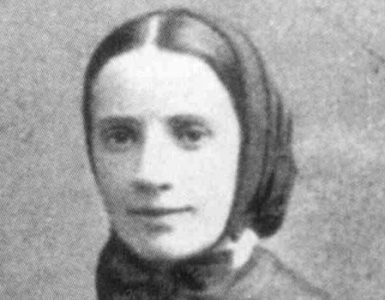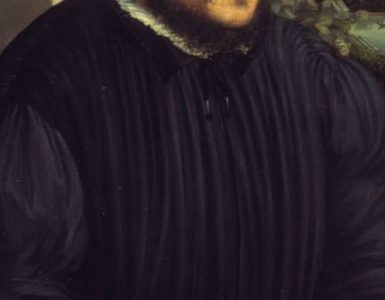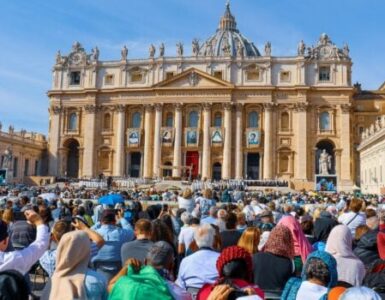“Never before did they know of God except to serve idols and unclean things. But now, they have become the people of the Lord, and are called children of God. The sons and daughters of the leaders of the Irish are seen to be monks and virgins of Christ!”
– St. Patrick, from the Confessio
Ireland’s Patron Saint, St. Patrick, is so famous in most Western and even some Eastern countries, that St. Patrick has engendered countless celebrations: people don green clothing, pin a shamrock to their shirt, grab a cup of Irish coffee, or go to a festive parade. Apparently, St. Patrick’s Day does have worldwide celebrants, including even in Norway, Turkey, Croatia, Japan, and Russia, plus others.
Father Bill John Melançon, pastor at St. Rita Catholic Church in Catahoula and St. Elizabeth Catholic Church in Coteau Holmes, Louisiana, noted that, indeed, plenty of people dash out to party on this saint’s day.
But at least in his parish, he noted, his parishioners aren’t out drinking beer during Mass. “We don’t do much,” he said. “We acknowledge St. Patrick at Mass. And this year, our bishops have allowed us in Lent to celebrate St. Patrick’s Day to have meat on this Friday, a feast day….I will celebrate by having a hamburger.” (Note: As published in the National Catholic Register on March 11, most U.S. Bishops are allowing Catholics to eat meat on St. Patrick’s Day, Friday, March 17.)
But as festive as this day may be, the celebrations really do not highlight the real St. Patrick. Probably one of the best known Catholic saints, St. Patrick, born Maewyn Succat in 386 A.D. in Britannia—is heralded as the “Apostle of Ireland” and its main patron saint. Legends note that as a youth, he was kidnapped by Irish bandits who forced him to tend his master’s flock of sheep. As he worked, he apparently prayed to God daily, receiving an angelic vision telling him to return to his homeland, where he committed his life to becoming a priest.
After his ordination, Maewyn Succat received another angelic visitation, urging him to return to Ireland to preach his faith and to convert the people to Catholicism. The then Pope, Pope Celestine, renamed him Patrick and missioned him to Ireland.
As a missionary there, St. Patrick has been credited with converting many people to Catholicism, leaving behind his legacy of founding churches and monasteries. But what historians cannot confirm are these: did he use the three-leafed shamrock to explain the Trinity? Did he rid Ireland of all the snakes? Did he originate the Celtic Cross? Whatever the historic truth may be, at least people love celebrating this saint’s day and wearing green.
Here are several heartwarming recipes that fellow celebrants love for the feast day:
Irish Potato Leek Soup
According to recipe donor, Peter Tapsak: “I should mention, for a heartier version, you can add chopped bacon, ham, or corned beef and go the potato-masher route instead of blending it.”
3 to 4 large russet potatoes
4 tablespoons butter
2 large leeks
1 yellow onion, peeled
3 garlic cloves,
4 cups chicken or vegetable stock
¼ cup heavy cream
Salt and pepper to taste
Sour cream
Diced parsley or chives for garnish, as desired
Directions:
Peel and dice potatoes to a consistent size, about ½-inch.
Trim the leeks, cutting off the root end and the tough dark green parts. Chop into ½” pieces and rinse the dirt off in a colander. Dice onion and garlic.
Heat butter in a large pot (enameled cast-iron or Dutch oven works great). Add leeks, onion, and garlic. Sauté until the onions are translucent and the leeks are soft, 5 t o10 minutes. Add stock and potatoes. Cover and reduce heat. Allow to simmer until potatoes are soft.
Remove from the heat and add the heavy cream. Purée with an immersion blender, or by transferring to a large blender in batches, or even by mashing with a potato masher, if you like a coarser texture.
Add salt and pepper to taste. Serve with a dollop of sour cream, and you can garnish with diced parsley or chives.
Cottage Pie
A comforting meal, this Irish dish is composed of ground beef and is topped with mashed potatoes. Depending on what supplies are in your kitchen, you may use vegetables such as peas, chopped carrots, and/or diced celery.
(Recipe credit: Chef Terry Walline, the now-closed Brion’s Grille, Fairfax, Virginia)
Serves 9
For the mashed potato topping
1 1/2 pounds potatoes, peeled and cubed
3 to 4 tablespoons unsalted butter
Milk as needed
Salt and freshly ground black pepper to taste
1/4 pound sharp Irish cheddar, shredded
About 1 cup diced scallionsFor the roux
1 cup unsalted butter
1 cup all-purpose flourFor the meat filling
1 tablespoon vegetable oil
1 1/2 pounds ground beef
1 large onion, peeled and diced
1 cup peas
1 cup diced carrots
1/8 cup minced garlic
1 cup Guinness beer
1 cup red wine
1 cup strong beef broth
2 teaspoons dried basil
2 teaspoons dried oregano
2 teaspoons dried sage
Directions
Salt and freshly ground black pepper to taste
Place the potatoes in a medium saucepan, and cover them with cold water. Place over high heat, cover, and bring to a boil. Once boiling, uncover, reduce the heat to a medium-low, and cook until fork tender, 10 to 15 minutes. Drain the potatoes, and return them to the saucepan. Mash the potatoes while adding butter, milk, salt and pepper, and continue to mash until smooth. Set aside.
Preheat the oven to 400 degrees.
To make the roux for thickening, melt the butter over medium heat, and whisk in the flour. Cook until the flour is absorbed, 2 to 3 minutes. Turn off the heat. (For more thickener, repeat this step with more ingredients.)
Prepare the meat filling by placing 1 tablespoon vegetable oil into a 12-inch sauté pan, and heat over medium-high heat. Add the ground beef, and cook until browned and cooked throughout, about 3 minutes; drain off the fat. Add the onions, peas, carrots, and garlic, and sauté just until they begin to turn golden, 3 to 4 minutes. Add the beer, wine, beef broth, basil, oregano, and sage, and stir to combine. Bring to a rapid boil, and whisk in roux slowly to thicken to desired consistency; reduce the heat to low; add salt and pepper to taste, and cook 1 to 2 minutes.
Add the meat filling mixture, and spread evenly into a 9- by 9-inch baking dish. Top with the mashed potatoes topping, starting around the edges to create a seal to prevent the mixture from bubbling up, and smooth with a spatula. Place on the middle rack of the oven.
Bake for 25 minutes or just until the potatoes begin to brown. Remove to a cooling rack, and sprinkle with cheese and scallions; cool for at least 15 minutes before serving.
Green, Green Salad
Serves 6 or more
1 1/2 pounds fresh spinach leaves
1/2 cup chopped parsley
5 tablespoons peanut oil
5 tablespoons olive oil
3 tablespoons wine vinegar
2 teaspoons Dijon mustard
2 garlic cloves, finely minced
Salt and freshly ground black pepper to taste
10 slices of bacon, fried crisp and crumbled into pieces
Trim off and discard tough stems or bruised leaves. Rinse the spinach well and pat dry. Combine the vinegar, oils, salt and pepper, mustard, garlic, and parsley. Blend well. When ready to serve, toss the spinach with the dressing and bacon and serve.
Irish Soda Bread
Donna Countryman of Irish heritage, who received this family recipe from her grandmother, noted that this traditional soda bread does not use yeast, and it is important to use buttermilk to get the proper flavor. Caraway seeds add an unusual and distinctive taste to this country-style bread.
Makes 2 loaves
5 cups sifted all-purpose flour
¾ cup granulated sugar
2 teaspoons baking powder
1 teaspoon baking soda
1½ teaspoons salt
1 stick unsalted butter
2½ cups raisins, soaked in warm water
3 tablespoons caraway seeds
2 ½ cups buttermilk
1 large egg, beaten
Directions
Preheat the oven to 350 degrees. Spray two 9-inch loaf pans with nonstick spray.
Stir the flour, sugar, baking powder, baking soda, and salt together in a large mixing bowl. Cut in the butter until the flour mixture resembles cornmeal. Drain the raisins and stir the raisins and caraway seeds into the dough. Stir in the buttermilk and egg just until all the flour is moistened. Divide the batter into half and spoon it into the prepared loaf pans.
Bake the loaves for about 1 hour, or until a toothpick inserted in the center comes out clean. Remove from the oven and cool the loaves before slicing.
Irish Shortbread Cookies
Recipe donor Mary Ball said this is a family favorite. European butter is her choice.
Makes 2 dozen
1 cup unsalted Irish butter
1/2 cup plus 1 tablespoon sugar
2 ½ cups all-purpose flour
1 to 2 tablespoons heavy cream, if needed
Directions
Remove butter from refrigerator 15 minutes ahead of time to soften. Preheat oven to 300 degrees. Line baking sheets with parchment paper and set aside.
Cream butter and sugar with paddle attachment of stand mixer. Turn mixer speed to low, and slowly add flour. Mix until dough forms a ball. Add cream, one tablespoon at a time, if needed to get dough to pull together.
On floured surface, roll dough out to ¼-inch thickness, and cut with cookie cutter. Place on lined cookie sheets. Bake until just turning golden, about 20 to 25 minutes. Remove from oven, and transfer to cooling rack. Cool completely.












